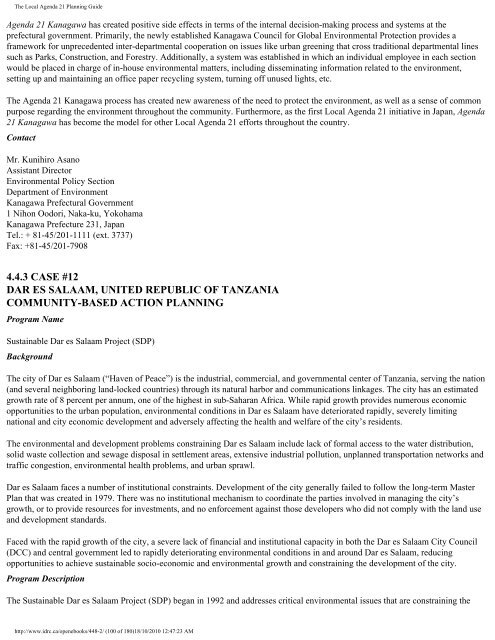The Local Agenda 21 Planning Guide - Democrats Against UN ...
The Local Agenda 21 Planning Guide - Democrats Against UN ...
The Local Agenda 21 Planning Guide - Democrats Against UN ...
You also want an ePaper? Increase the reach of your titles
YUMPU automatically turns print PDFs into web optimized ePapers that Google loves.
<strong>The</strong> <strong>Local</strong> <strong>Agenda</strong> <strong>21</strong> <strong>Planning</strong> <strong>Guide</strong><br />
<strong>Agenda</strong> <strong>21</strong> Kanagawa has created positive side effects in terms of the internal decision-making process and systems at the<br />
prefectural government. Primarily, the newly established Kanagawa Council for Global Environmental Protection provides a<br />
framework for unprecedented inter-departmental cooperation on issues like urban greening that cross traditional departmental lines<br />
such as Parks, Construction, and Forestry. Additionally, a system was established in which an individual employee in each section<br />
would be placed in charge of in-house environmental matters, including disseminating information related to the environment,<br />
setting up and maintaining an office paper recycling system, turning off unused lights, etc.<br />
<strong>The</strong> <strong>Agenda</strong> <strong>21</strong> Kanagawa process has created new awareness of the need to protect the environment, as well as a sense of common<br />
purpose regarding the environment throughout the community. Furthermore, as the first <strong>Local</strong> <strong>Agenda</strong> <strong>21</strong> initiative in Japan, <strong>Agenda</strong><br />
<strong>21</strong> Kanagawa has become the model for other <strong>Local</strong> <strong>Agenda</strong> <strong>21</strong> efforts throughout the country.<br />
Contact<br />
Mr. Kunihiro Asano<br />
Assistant Director<br />
Environmental Policy Section<br />
Department of Environment<br />
Kanagawa Prefectural Government<br />
1 Nihon Oodori, Naka-ku, Yokohama<br />
Kanagawa Prefecture 231, Japan<br />
Tel.: + 81-45/201-1111 (ext. 3737)<br />
Fax: +81-45/201-7908<br />
4.4.3 CASE #12<br />
DAR ES SALAAM, <strong>UN</strong>ITED REPUBLIC OF TANZANIA<br />
COMM<strong>UN</strong>ITY-BASED ACTION PLANNING<br />
Program Name<br />
Sustainable Dar es Salaam Project (SDP)<br />
Background<br />
<strong>The</strong> city of Dar es Salaam (“Haven of Peace”) is the industrial, commercial, and governmental center of Tanzania, serving the nation<br />
(and several neighboring land-locked countries) through its natural harbor and communications linkages. <strong>The</strong> city has an estimated<br />
growth rate of 8 percent per annum, one of the highest in sub-Saharan Africa. While rapid growth provides numerous economic<br />
opportunities to the urban population, environmental conditions in Dar es Salaam have deteriorated rapidly, severely limiting<br />
national and city economic development and adversely affecting the health and welfare of the city’s residents.<br />
<strong>The</strong> environmental and development problems constraining Dar es Salaam include lack of formal access to the water distribution,<br />
solid waste collection and sewage disposal in settlement areas, extensive industrial pollution, unplanned transportation networks and<br />
traffic congestion, environmental health problems, and urban sprawl.<br />
Dar es Salaam faces a number of institutional constraints. Development of the city generally failed to follow the long-term Master<br />
Plan that was created in 1979. <strong>The</strong>re was no institutional mechanism to coordinate the parties involved in managing the city’s<br />
growth, or to provide resources for investments, and no enforcement against those developers who did not comply with the land use<br />
and development standards.<br />
Faced with the rapid growth of the city, a severe lack of financial and institutional capacity in both the Dar es Salaam City Council<br />
(DCC) and central government led to rapidly deteriorating environmental conditions in and around Dar es Salaam, reducing<br />
opportunities to achieve sustainable socio-economic and environmental growth and constraining the development of the city.<br />
Program Description<br />
<strong>The</strong> Sustainable Dar es Salaam Project (SDP) began in 1992 and addresses critical environmental issues that are constraining the<br />
http://www.idrc.ca/openebooks/448-2/ (100 of 180)18/10/2010 12:47:23 AM










